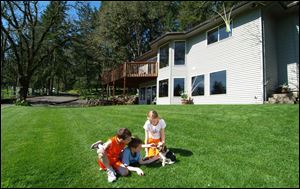
The Dirt on Gorgeous Grass
6/18/2010
Before you waste time and money on a no-win lawn care program, consider whether soil problems stand between you and gorgeous grass.
(ARA) - Break out the Bermuda shorts and stride out onto your lawn -- which is even more thin and weedy than last year. You faithfully fertilize, seed, apply weed killer and water. What are you doing wrong?
Here's the real dirt on what makes a lawn lush -- it's what's under the grass that counts. Your lawn can't flourish without a foundation of healthy soil. If your lawn is sparse and weed-filled, the real issue might lie just below the root zone, in the soil.
So how do you achieve healthy soil? By tackling common soil issues like poor drainage, soil compaction, thatch buildup and poor pH. Grass can't thrive if its roots are waterlogged, struggling in dense or nutrient-poor soil, or smothered under a thick barrier of thatch, a layer of plant debris at the base of the grass blade.
Before wasting time and money on a no-win lawn care program, consider whether soil problems are standing between you and gorgeous grass.
*Poor drainage -- Water puddling on the surface after rain or irrigation means moisture isn't draining freely to deeper soil levels. Healthy soil is porous, allowing air and nutrients to reach plant roots. Roots can actually drown and rot away in waterlogged soil.
*Soil compaction -- Soil is easily compressed under constant foot traffic and by the heavy equipment used to care for lawns -- riding mowers and heavy wheelbarrows, for instance. Compacted soil keeps air and nutrients from reaching the root system, leaving it shallow and weak. Test for compaction by digging up a shovelful of turf and soil. If the ground is hard to pierce or the soil sample is dense and hard to break up, the lawn bed needs to be aerated.
*Thatch -- Take a second look at your test hole. If you've revealed a layer of debris thicker than half an inch, it may be time to remove the thatch. In ideal conditions, grass clippings, leaves, twig fragments and other debris that falls on the lawn break down, providing nutrients to the grass. But if the soil organisms responsible for decomposition aren't present, thatch builds up, creating a layer at the soil surface that sheds water and nutrients.
* pH -- Simply put, pH is a measure of how acidic or alkaline your soil is. If your soil's pH is out of balance, you can correct it by adding the proper amendments.
There are time-tested tactics to tackle these problems by mechanical means, and much newer, effective and easy treatments developed by soil scientists to improve conditions beneath the turf.
Mechanical core aerators, available for rent, pull up finger-sized cores from the lawn, leaving them on the surface to dissolve. The plugs will dissolve over time, but they're ugly until they do. Plus, mechanical aeration can bring up weed seeds from the soil bank. Renting an aerator or a power thatching mower can be expensive and the process is labor-intensive. Courtesy of ARAcontent